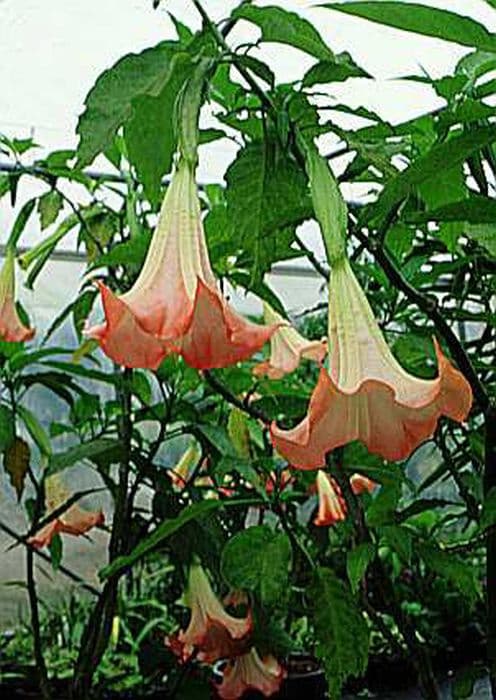Million Bells Calibrachoa Romantic Rose (Romantic Series)
![calibrachoa [Romantic Rose]](/_next/image?url=https%3A%2F%2Fplants-admin.emdemapps.com%2Fimages%2Fplants%2F%2Fimages%2F604b556c552e4.png&w=3840&q=75)
ABOUT
Calibrachoa Romantic Rose, often simply referred to as Calibrachoa, is a charming and visually striking plant renowned for its vibrant, showy flowers that resemble miniature petunias. This particular variety, belonging to the Romantic Series, flaunts breathtaking blossoms characterized by their delicate rose-pink hues, which may display a gradient of color intensity, often with a more saturated heart that gently fades out towards the petal edges. The petals are soft to the touch, featuring a smooth texture, and they usually exhibit a slightly ruffled look that adds a touch of whimsicality to the overall appearance. Each bloom typically consists of a funnel shape, with five slightly merged petals culminating into a flared opening. Moreover, the Romantic Rose variety displays a profusion of these petite flowers, creating an abundant and lush look. The blooms cluster above the foliage, which is known for its dense, green leaves that have a small, narrow, and somewhat pointed shape. The leaves provide a verdant backdrop that further accentuates the captivating allure of the rose-like flowers. The overall demeanor of the Calibrachoa Romantic Rose is one of cascading opulence. Its growth habit tends to be trailing or slightly mounded, lending itself beautifully to hanging baskets, containers, or as a striking ground cover where an eruption of color is desired. The continuous blooming nature of this plant ensures an enduring display of floral splendor through the warmer months.
About this plant
 Names
NamesFamily
Solanaceae
Synonyms
Million Bells, Mini Petunia
Common names
Calibrachoa Romantic Rose.
 Toxicity
ToxicityTo humans
The plant commonly known as Calibrachoa is not known to be toxic to humans. Therefore, ingesting parts of this plant is not expected to cause poisoning or adverse health effects.
To pets
Calibrachoa is not considered toxic to pets. Ingestion of this plant should not result in poisoning or serious consequences for animals such as cats and dogs. However, it is always a good practice to keep an eye on pets and prevent them from eating plants, as individual animals can have varying sensitivities.
 Characteristics
CharacteristicsLife cycle
Annuals
Foliage type
Evergreen
Color of leaves
Green
Flower color
Pink
Height
6-10 inches (15-25 cm)
Spread
12-24 inches (30-61 cm)
Plant type
Herb
Hardiness zones
9
Native area
South America
Benefits
 General Benefits
General Benefits- Easy to grow – Calibrachoa is a low-maintenance plant that thrives with minimal care.
- Continuous blooms – Provides long-lasting flowers from spring until frost, adding consistent beauty to gardens.
- Attracts pollinators – Flowers attract hummingbirds, butterflies, and other beneficial pollinators.
- Compact growth – Its dwarf habit is perfect for small gardens or hanging baskets.
- Versatile – Ideal for containers, borders, and as a ground cover.
- Drought tolerant – Once established, it can tolerate periods of dryness.
- Vibrant colors – Offers rich, deep rose-colored flowers that add a pop of color to any setting.
- Resilient – Shows good resistance to common garden pests and diseases.
 Medical Properties
Medical PropertiesThis plant is not used for medical purposes.
 Air-purifying Qualities
Air-purifying QualitiesThis plant is not specifically known for air purifying qualities.
 Other Uses
Other Uses- Photography Subject: With its delicate petals and eye-catching hues, Calibrachoa can serve as an excellent subject for macro photography, allowing photographers to capture the intricacies of its structure.
- Educational Tool: Calibrachoa can be used in the classroom to teach students about plant biology, life cycles, and pollination processes due to their ease of growth and vibrant colors.
- Artistic Inspiration: Artists may use Calibrachoa as a muse for paintings, drawings, and other forms of art, capturing its romantic aesthetic.
- Event Decor: Small pots of Calibrachoa can be used as living table centerpieces for weddings and other events, adding a romantic touch to the decor.
- Fairy Gardens: Calibrachoa can be ideal for creating enchanted fairy gardens due to their miniature bell-shaped flowers and variety of colors.
- Petal Confetti: Dried Calibrachoa petals can be used as biodegradable confetti for outdoor celebrations, providing an eco-friendly alternative to plastic confetti.
- Natural Dyes: The pigments from Calibrachoa petals could potentially be used to create natural dyes for fabrics or crafts, although specific recipes may need experimentation.
- Culinary Garnishing: Although not commonly known for culinary uses, the flowers can be used as vibrant, edible garnishes for salads and desserts after ensuring they are free from pesticides.
- Journaling and Scrapbooking: Pressed flowers of Calibrachoa can be used to embellish journal pages or scrapbooks, adding a touch of nature to the pages.
- Color Therapy: Their colorful blossoms can be used in color therapy practices to create a soothing and aesthetically pleasing environment that promotes relaxation and wellbeing.
Interesting Facts
 Feng Shui
Feng ShuiThe Calibrachoa is not used in Feng Shui practice.
 Zodiac Sign Compitability
Zodiac Sign CompitabilityThe Calibrachoa is not used in astrology practice.
 Plant Symbolism
Plant Symbolism- Enduring Love: The 'Romantic' in the Calibrachoa Romantic Rose suggests a symbolism of lasting affection, much like the endurance of a rose in literature and culture.
- Charm and Attraction: The captivating colors and gentle cascade of Calibrachoa blossoms can represent the allure and magnetism one person may feel for another.
- Nostalgia: Often reminiscent of vintage or classic gardening styles, this plant can symbolize a longing for the past or the beauty of cherished memories.
- Gratitude: The generous blossoming of the Calibrachoa Romantic Rose can symbolize appreciation and thankfulness, making it a perfect gift to express gratitude.
- Intimacy: The close cluster of flowers on this plant reflects the intimacy and closeness between people, whether in friendship or romantic relationships.
 Water
WaterMillion bells, commonly known as Calibrachoa 'Romantic Rose', should ideally be watered when the top inch of soil feels dry to the touch. Depending on the temperature and humidity, this could be every couple of days during active growth in the warmer months. Water the plant thoroughly until water runs out of the drainage holes, indicating that the soil is fully saturated. In general, it's better to provide a deep watering less often than to water lightly more frequently, as this encourages deeper root growth. Provide approximately 16-24 ounces of water per plant for each watering session, though this may vary slightly based on the plant's environment and pot size.
 Light
LightMillion bells enjoys full sun to part shade lighting conditions. The best spot for this plant is where it can receive at least 6 hours of direct sunlight each day, though it can tolerate some light shade. To achieve optimal blooming, placing the plant in a location with ample morning sunlight and some protection from the intense afternoon sun is ideal.
 Temperature
TemperatureMillion bells thrives in temperatures between 55 and 65 degrees Fahrenheit at night and between 65 and 85 degrees Fahrenheit during the day. It can tolerate a minimum temperature down to about 40 degrees Fahrenheit for short periods, but frost or prolonged cold will damage the plant. The ideal temperature range for flourishing growth and bloom production is within that 65 to 85-degree Fahrenheit window during the day.
 Pruning
PruningMillion bells benefits from periodic pruning to encourage bushier growth and more blooms. Pinch back the stems every few weeks, removing the tip of the stem to stimulate branching. The best time to prune is in the late spring or early summer, just as the plant is beginning its active growth phase. Regular deadheading, or removal of spent flowers, will also keep the plant looking tidy and promote continuous flowering throughout the season.
 Cleaning
CleaningAs needed
 Soil
SoilMillion Bells thrive in well-draining, fertile soil with a pH between 5.5 and 6.0. A good mix can be made from peat moss, perlite, and potting soil in equal parts to ensure proper drainage and aeration.
 Repotting
RepottingMillion Bells typically do not require frequent repotting and can be repotted every 1-2 years or as needed when they outgrow their current container.
 Humidity & Misting
Humidity & MistingMillion Bells prefer moderate humidity levels but are adaptable to various conditions and do not require specific humidity adjustments.
 Suitable locations
Suitable locationsIndoor
Ensure bright light, moderate watering, and well-draining soil mix.
Outdoor
Place in full sun to part shade and in well-drained soil.
Hardiness zone
9-11 USDA
 Life cycle
Life cycleThe life cycle of the Calibrachoa, commonly known as Million Bells, starts with seed germination, where warmth and moisture trigger the sprouting of roots and shoots. This progresses to the seedling stage, where the plant develops its first true leaves and roots strengthen, requiring adequate light and water. As it enters the vegetative stage, the plant grows rapidly, producing more leaves and stems, and must be fertilized regularly. During the flowering stage, the Calibrachoa Romantic Rose blooms prolifically, displaying rose-pink flowers that attract pollinators. Post-pollination, the plant may produce seeds, completing its reproductive cycle. Finally, as an annual or short-lived perennial in some climates, the plant will die after the growing season unless protected or indoor conditions mimic its preferred environment.
 Propogation
PropogationPropogation time
Spring-Summer
The most popular method for propagating Calibrachoa, commonly known as Million Bells, is through softwood cuttings. This is typically done in late spring or early summer. One would take a healthy stem that has not yet flowered and cut a 3-6 inch (about 7.5-15 centimeters) segment. The lower leaves are then removed, and the stem cutting is dipped in a rooting hormone to encourage root development. After preparing the cutting, it is placed in a well-draining potting mix. Proper humidity is maintained by covering the pot with a plastic bag or placing it in a propagator, and placed in indirect light. Roots generally develop in a few weeks, after which it can be gradually acclimatized to normal growing conditions.


![Calibrachoa [Aloha Classic Blue Sky]](/_next/image?url=https%3A%2F%2Fplants-admin.emdemapps.com%2Fimages%2Fplants%2F%2Fimages%2F604b636c3778b.png&w=640&q=75)
![Calibrachoa [Aloha Classic Gold]](/_next/image?url=https%3A%2F%2Fplants-admin.emdemapps.com%2Fimages%2Fplants%2F%2Fimages%2F604b6284c573e.png&w=640&q=75)
![Calibrachoa [Aloha Classic Tiki Soft Pink]](/_next/image?url=https%3A%2F%2Fplants-admin.emdemapps.com%2Fimages%2Fplants%2F%2Fimages%2F604b548e0a5ef.png&w=640&q=75)
![Calibrachoa [Cabaret Deep Yellow]](/_next/image?url=https%3A%2F%2Fplants-admin.emdemapps.com%2Fimages%2Fplants%2F%2Fimages%2F604b5f20ca3ef.png&w=640&q=75)
![Calibrachoa [Calibasket Radiant Orange]](/_next/image?url=https%3A%2F%2Fplants-admin.emdemapps.com%2Fimages%2Fplants%2F%2Fimages%2F604b536d43cb2.png&w=640&q=75)
![Calibrachoa [Caloha Classic Blue Velvet]](/_next/image?url=https%3A%2F%2Fplants-admin.emdemapps.com%2Fimages%2Fplants%2F%2Fimages%2F604b604884a75.png&w=640&q=75)
![Calibrachoa [Caloha Classic Honey White]](/_next/image?url=https%3A%2F%2Fplants-admin.emdemapps.com%2Fimages%2Fplants%2F%2Fimages%2F604b5f56e0beb.png&w=640&q=75)
![Calibrachoa [Caloha Classic Yellow Chocolate Ring]](/_next/image?url=https%3A%2F%2Fplants-admin.emdemapps.com%2Fimages%2Fplants%2F%2Fimages%2F604b538aede95.png&w=640&q=75)